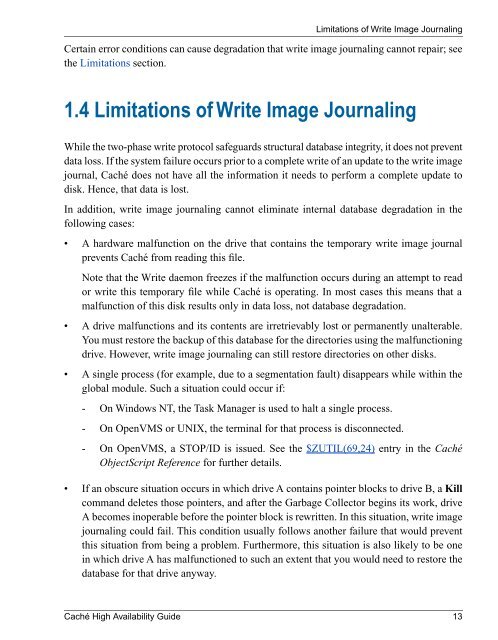Caché High Availability Guide - InterSystems Documentation
Caché High Availability Guide - InterSystems Documentation
Caché High Availability Guide - InterSystems Documentation
Create successful ePaper yourself
Turn your PDF publications into a flip-book with our unique Google optimized e-Paper software.
Limitations of Write Image JournalingCertain error conditions can cause degradation that write image journaling cannot repair; seethe Limitations section.1.4 Limitations of Write Image JournalingWhile the two-phase write protocol safeguards structural database integrity, it does not preventdata loss. If the system failure occurs prior to a complete write of an update to the write imagejournal, <strong>Caché</strong> does not have all the information it needs to perform a complete update todisk. Hence, that data is lost.In addition, write image journaling cannot eliminate internal database degradation in thefollowing cases:• A hardware malfunction on the drive that contains the temporary write image journalprevents <strong>Caché</strong> from reading this file.Note that the Write daemon freezes if the malfunction occurs during an attempt to reador write this temporary file while <strong>Caché</strong> is operating. In most cases this means that amalfunction of this disk results only in data loss, not database degradation.• A drive malfunctions and its contents are irretrievably lost or permanently unalterable.You must restore the backup of this database for the directories using the malfunctioningdrive. However, write image journaling can still restore directories on other disks.• A single process (for example, due to a segmentation fault) disappears while within theglobal module. Such a situation could occur if:- On Windows NT, the Task Manager is used to halt a single process.- On OpenVMS or UNIX, the terminal for that process is disconnected.- On OpenVMS, a STOP/ID is issued. See the $ZUTIL(69,24) entry in the <strong>Caché</strong>ObjectScript Reference for further details.• If an obscure situation occurs in which drive A contains pointer blocks to drive B, a Killcommand deletes those pointers, and after the Garbage Collector begins its work, driveA becomes inoperable before the pointer block is rewritten. In this situation, write imagejournaling could fail. This condition usually follows another failure that would preventthis situation from being a problem. Furthermore, this situation is also likely to be onein which drive A has malfunctioned to such an extent that you would need to restore thedatabase for that drive anyway.<strong>Caché</strong> <strong>High</strong> <strong>Availability</strong> <strong>Guide</strong> 13

















